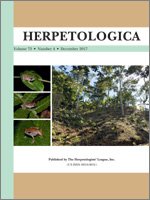Environmental factors play an important role in structuring communities. In heterogeneous environments, where habitat structure might vary considerably, understanding how these factors shape communities is one of the most important issues in community ecology. In this context, we investigated how environmental factors contributed to the composition of five frog communities on the sandy coastal plains (restinga ecosystem) of southeastern Brazil. We sampled these ecosystems over a 2-yr period and compared five sites in relation to their habitat structure, frog species composition, species abundance, and their distribution in different mesohabitats. We found that the composition of the amphibian communities was not related systematically to habitat structure in general, but rather to the availability of spawning sites (sources of freestanding water), which appears to be the most important ecological factor structuring these communities.
How to translate text using browser tools
1 December 2017
Local Environmental Factors Influence the Structure of Frog Communities on the Sandy Coastal Plains of Southeastern Brazil
Jane C.F. de Oliveira,
Gisele R. Winck,
Juliane Pereira-Ribeiro,
Carlos Frederico Duarte Rocha
ACCESS THE FULL ARTICLE

Herpetologica
Vol. 73 • No. 4
December 2017
Vol. 73 • No. 4
December 2017
Anurans
Atlantic rainforest biome
community structure
environmental variables
resources
Spawning sites




